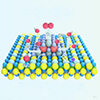| Sep 26, 2022 |
|
(Nanowerk News) Our excessive consumption of fossil fuels is responsible for some of the major societal challenges we are facing, from climate change to pollution. Hydrogen is considered a green alternative to fossil fuels, and alkaline water electrolysis is proving an attractive technology for large-scale commercialisation of hydrogen production.
|
|
However, current industrial applications of electrocatalytic water splitting are limited by the high overpotential of the oxygen evolution reaction (OER); an important electrochemical reaction in the process. This is especially true when operating at high electrical current densities (500-1000 mA cm-2).
|
|
In a study published in the KeAi journal Green Energy & Environment (“Molecular-level proton acceptor boosts oxygen evolution catalysis to enable efficient industrial-scale water splitting”), a group of researchers from China describe a process they have developed to address this challenge.
|
 |
| Comparison between the reaction mechanisms of a hybrid system with a conventional heterostructure, and the single-phase system with molecular-level proton acceptors developed by the researchers. (Image: Nanjing University of Information Science and Technology)
|
|
Prof. Yunfei Bu from China’s Nanjing University of Information Science and Technology led the research. He explains: “Because OER involves four complex proton-electron coordination transfer steps in alkaline media, the level of proton/electron transfer you can achieve is limited. To address that, we constructed a simple and scalable proton acceptor strategy which reduces the size of the proton acceptors to the molecular-level and integrates them into the whole catalyst.”
|
|
Yaobin Wang, a PhD student at the same university, came up with the new method and, according to co-author Dr. Feng Li, a professor at China’s Fudan University, the reason it works so well is because the “molecular-level design increases the direct connection between the surface proton-acceptor and the carrier, and solves the existing problems around a long transfer path, limited interface and loose contact. This results in improved proton transfer kinetics under high current.”
|
|
The study also evaluated the water electrolysis performance of the catalyst under practical conditions, by using a membrane electrode assembly. According to the researchers, the electrolyser can achieve a high current density of 500 mA cm-2 or even 1000 mA cm-2 at low overpotential, and the overall Faraday is close to 96%.
|
|
Prof. Bu concludes: “This new strategy shows great application prospects in practical water electrolysis devices and high-current industrial applications. In addition, this functional modification at the molecular level has the potential to be extended to more catalytic fields.”
|


